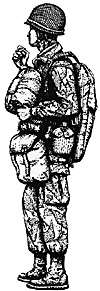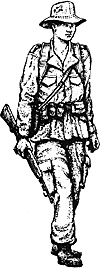Viet-Minh Soldier
The soldiers of the Viet-Minh People's Army were recruited primarily from the native peasant population. Although unimpressive in size averaging just over five feet in height and 118 pounds in weight the Viet-Minh soldier was inured to hardship and very adaptable. His usual diet was cold glutinous rice, his pay and medical care were often non-existent and most of his light weapons and equipment were caputred from the French with heavy armaments from the Communist Bloc. Whether staging a raid or a massive assault, the Viet-Minh units were always carefully briefed and rehearsd. Masters of guerrilla warfare, the Viet-Minh could be used with success in conventional warfare as long as they had numerical superiority and tactical advantage over their for.
French Paratrooper
The paratrooper formed the elite units of the French Union forces in Indochina. Most of the airborne battalions operated with 700 men and were a mixture of Europeans and Vietnamese, a combination which helped the latter in their military training and gave the units the benefit of the knowledge of local terrain and language. The paratroopers were equipped with surplus material and weapons from the United States. Although aggressive and effective on the offensive, the lightly-armed paratroopers were not comfortable in static defensive warfare.Infantryman of the French Union Forces
The infantry of the French garrison at Dien Bien Phu was a professional force, composed of overseas units from Morocco and Algeria and e/ements of the French Foreign Legron. Operating in battalion strength, the infantry men used surplus U. S. equipment and French and American light arms. Trained according to the lessons of World War II land combat in Europe, the infantry could be an effective anti-guerrilla force when backed up by artillery and air support. The Moroccans and Algerians fought when well led, but collapsed if their commanders were lost.
T'ai Auxilliary
Natives of the Dien Bien Phu valley, the T'ai tribesmen fought for both the Viet-Minh and the French. Armed as light infantry, the T'ai soldiers were organized into homogeneous units, such as the French Irregular Light Companies and the regiments of the 316th Viet-Minh Division, although care had to be taken in both armies to keep separated members of the rival "White" and "Black" T'ai factions. The tribesmen also acted as guides and porters for the long-range patrols of the Communists and the French. Fighting for personal loyalty and revenge, as well as money, the T'ai tribesmen were good auxiliaries when led by sympathetic officers and near their home ground. Otherwise, they could be expected to desert, often leaving behind their second-hand weapons and equipment.
| Viet-Minh Soldier
|
French Paratrooper
|
French Union Infantry
|
T'ai Auxilliary
|
More Dien Bien Phu
-
Dien Bien Phu: Introduction
Dien Bien Phu: French Arrival: 20 Nov. 1953
Dien Bien Phu: Vietnamese Attack: 13 Mar. 1954
Dien Bien Phu: French Counterattack: 10 Apr. 1954
Dien Bien Phu: Soldiers
Dien Bien Phu: Weaponry
Dien Bien Phu: French Order of Battle
Dien Bien Phu: Viet-Minh Order of Battle
Dien Bien Phu: Map: Last Days May 1-7 (slow: 126K)
Back to Conflict Number 6 Table of Contents
Back to Conflict List of Issues
Back to MagWeb Master Magazine List
© Copyright 1973 by Dana Lombardy
This article appears in MagWeb (Magazine Web) on the Internet World Wide Web.
Other military history articles and gaming articles are available at http://www.magweb.com



